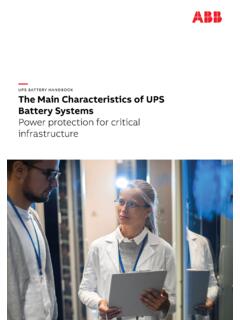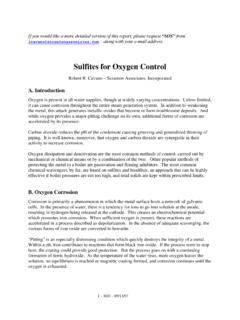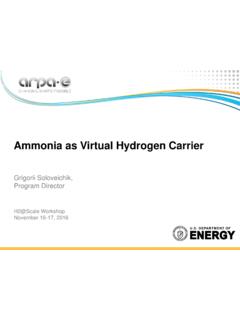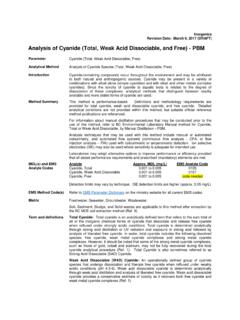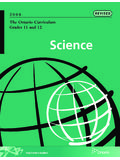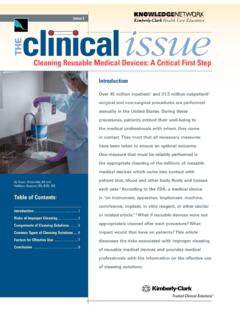Transcription of BIOCHEMISTRY LAB MANUAL - Komar University of Science …
1 BIOCHEMISTRY Lab (CHM2415C) MLS. BIOCHEMISTRY LAB MANUAL . (CHM2415C). Dlshad Ghafoor Fall 2016. 1. BIOCHEMISTRY Lab (CHM2415C) MLS. Introduction The aim of the following set of experiments is to acquaint students with some basics in understanding BIOCHEMISTRY lab and Biochemical. This BIOCHEMISTRY laboratory seeks to introduce undergraduate students techniques used in BIOCHEMISTRY . A collection of eleven experiments has been presented that teach students how to detect, estimate different biomolecules with simple equipment. Each experiment set introduces a theoretical principle and the needed equipment and chemicals used in each experiment. Course objectives -This course regarded as an introduction to basic BIOCHEMISTRY and will be useful for students who want to study clinical chemistry. -The course uses simple protocols and available materials and instruments to understand Biochemical substances. -Some experiments were put to teach students how to work independently in the any Lab.
2 - Modern lab researchers should know the principles of the biochemical methods of analysis and to learn the main theoretical statements. For it, medical Lab Science students have to get the minimum of MANUAL skills during a research of BIOCHEMISTRY , eg. measuring out solutions and biological liquids, centrifugation, colorimetry of colored solutions, determination of pH, peculiarities of the technique of enzyme investigations etc. The given MANUAL contains the Descriptions of the biochemical methods of analysis which all the skills are required in. 2. BIOCHEMISTRY Lab (CHM2415C) MLS. Table of Contents Introduction .. Error! Bookmark not defined. Course objectives ..2. Table of Contents ..3. Introduction to the BIOCHEMISTRY lab ..4. Safety Rules ..4. Lab reports .. Error! Bookmark not defined. Lab 1: Carbohydrate Qualitative tests .. Error! Bookmark not defined. Lab2: Carbohydrate quantitative tests 25. Lab 3: Amino acids and protein qualitative tests . 27.
3 Lab 4: Quantitative determination of proteins by biuret reagent ..40. Lab 5: Lipids Qualitative tests .42. Lab 6: Vitamins, Qualitative and Quantitative tests ..49. Lab 7: Amino acids titration curves 53. Lab 8: RNA preparation and Qualitative tests .58. Lab 9: Horizontal and Vertical Electrophoresis .59. Lab 10: Test for a solid unknown ..60. Lab11: Test for a liquid unknown 61. 3. BIOCHEMISTRY Lab (CHM2415C) MLS. Introduction to the BIOCHEMISTRY lab (Rules for laboratory experiments, laboratory Safety Signs/Labels and laboratory reports). 1. Safety Rules: What are the Safety Do's and Don'ts for Students? Life threatening injuries can happen in the laboratory. For that reason, students need to be informed of the correct way to act and things to do in the laboratory. The following is a safety checklist that can be used as a handout to students to acquaint them with the safety do's and don'ts in the laboratory. Conduct - Do not engage in practical jokes or boisterous conduct in the laboratory.
4 - Never run in the laboratory. - The use of personal audio or video equipment is prohibited in the laboratory. - The performance of unauthorized experiments is strictly forbidden. - Do not sit on laboratory benches. General Work Procedure - Know emergency procedures. - Never work in the laboratory without the supervision of a teacher. - Always perform the experiments or work precisely as directed by the teacher. - Immediately report any spills, accidents, or injuries to a teacher. - Never leave experiments while in progress. - Be careful when handling hot glassware and apparatus in the laboratory. Hot glassware looks just like cold glassware. - Never point the open end of a test tube containing a substance at yourself or others. - Never fill a pipette using mouth suction. Always use a pipetting device. - Make sure no flammable solvents are in the surrounding area when lighting a flame. - Do not leave lit Bunsen burners unattended. - Turn off all heating apparatus, gas valves, and water faucets when not in use.
5 - Do not remove any equipment or chemicals from the laboratory. - Coats, bags, and other personal items must be stored in designated areas, not on the bench tops or in the aisle ways. - Notify your teacher of any sensitivities that you may have to particular chemicals if known. - Keep the floor clear of all objects ( , ice, small objects, and spilled liquids). 4. BIOCHEMISTRY Lab (CHM2415C) MLS. Housekeeping - Keep work area neat and free of any unnecessary objects. - Thoroughly clean your laboratory work space at the end of the laboratory session. - Do not block the sink drains with debris. - Never block access to exits or emergency equipment. - Inspect all equipment for damage (cracks, defects, etc.) prior to use; do not use damaged equipment. - Never pour chemical waste into the sink drains or wastebaskets. - Place chemical waste in appropriately labeled waste containers. - Properly dispose of broken glassware and other sharp objects ( , syringe needles) immediately in designated containers.
6 - Properly dispose of weigh boats, gloves, filter paper, and paper towels in the laboratory. Apparel in the Laboratory - Always wear appropriate eye protection ( , chemical splash goggles) in the laboratory. - Wear disposable gloves, as provided in the laboratory, when handling hazardous materials. Remove the gloves before exiting the laboratory. - Wear a full-length, long-sleeved laboratory coat or chemical-resistant apron. - Wear shoes that adequately cover the whole foot; low-heeled shoes with non-slip soles are preferable. Do not wear sandals, open-toed shoes, open-backed shoes, or high -heeled shoes in the laboratory. - Avoid wearing shirts exposing the torso, shorts, or short skirts; long pants that completely cover the legs are preferable. - Secure long hair and loose clothing (especially loose long sleeves, neck ties, or scarves). - Remove jewelry (especially dangling jewelry). - Synthetic finger nails are not recommended in the laboratory; they are made of extremely flammable polymers which can burn to completion and are not easily extinguished.
7 Hygiene Practices - Keep your hands away from your face, eyes, mouth, and body while using chemicals. - Food and drink, open or closed, should never be brought into the laboratory or chemical storage area. - Never use laboratory glassware for eating or drinking purposes. - Do not apply cosmetics while in the laboratory or storage area. - Wash hands after removing gloves, and before leaving the laboratory. - Remove any protective equipment ( , gloves, lab coat or apron, chemical splash goggles) before leaving the laboratory. 5. BIOCHEMISTRY Lab (CHM2415C) MLS. Emergency Procedure - Know the location of all the exits in the laboratory and building. - Know the location of the emergency phone. - Know the location of and know how to operate the following: - Fire extinguishers - Alarm systems with pull stations - Fire blankets - Eye washes - First-aid kits - Deluge safety showers - In case of an emergency or accident, follow the established emergency plan as explained by the teacher and evacuate the building via the nearest exit.
8 Chemical Handling - Check the label to verify it is the correct substance before using it. - Wear appropriate chemical resistant gloves before handling chemicals. Gloves are not universally protective against all chemicals. - If you transfer chemicals from their original containers, label chemical containers as to the contents, concentration, hazard, date, and your initials. - Always use a spatula or scoopula to remove a solid reagent from a container. - Do not directly touch any chemical with your hands. - Never use a metal spatula when working with peroxides. Metals will decompose explosively with peroxides. - Hold containers away from the body when transferring a chemical or solution from one container to another. - Use a hot water bath to heat flammable liquids. Never heat directly with a flame. - Add concentrated acid to water slowly. Never add water to a concentrated acid. - Weigh out or remove only the amount of chemical you will need. Do not return the excess to its original container, but properly dispose of it in the appropriate waste container.
9 - Never touch, taste, or smell any reagents. - Never place the container directly under your nose and inhale the vapors. - Never mix or use chemicals not called for in the laboratory exercise. - Clean up all spills properly and promptly as instructed by the teacher. - Dispose of chemicals as instructed by the teacher. - When transporting chemicals (especially 250 mL or more), place the immediate container in a secondary container or bucket (rubber, metal or plastic) designed to be carried and large enough to hold the entire contents of the chemical. - Never handle bottles that are wet or too heavy for you. - Use equipment (glassware, Bunsen burner, etc.) in the correct way, as indicated by the teacher. 6. BIOCHEMISTRY Lab (CHM2415C) MLS. Chemical Waste - All containers used for chemical waste should be labeled with: WASTE or HAZARDOUS WASTE . Chemical name (as it appears on the MSDS). Accumulation start date Hazard(s) associated with the chemical waste Storage Don'ts - Do not place heavy materials, liquid chemicals, and large containers on high shelves.
10 - Do not store chemicals on tops of cabinets. - Do not store chemicals on the floor, even temporarily. - Do not store items on bench tops and in laboratory chemical hoods, except when in use. - Do not store chemicals on shelves above eye level. - Do not store chemicals with food and drink. - Do not store chemicals in personal staff refrigerators, even temporarily. - Do not expose stored chemicals to direct heat or sunlight, or highly variable temperatures. Proper Use of Chemical Storage Containers - Never use food containers for chemical storage. - Make sure all containers are properly closed. - After each use, carefully wipe down the outside of the container with a paper towel before returning it to the storage area. Properly dispose of the paper towel after use. 7. BIOCHEMISTRY Lab (CHM2415C) MLS. 8. BIOCHEMISTRY Lab (CHM2415C) MLS. 2. Lab Reports: Lab reports should be filled using the following format or style: Lab Report Form Course name ---------------------------------------- ---- Course number-Lab section The title of the experiment ---------------------------------------- ---- Date ---------------------------------------- ---- Student name (registration no.)
